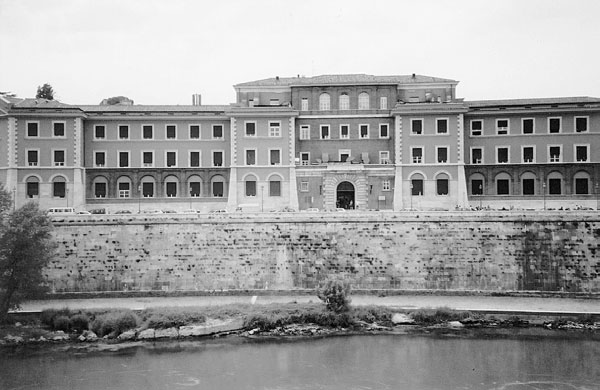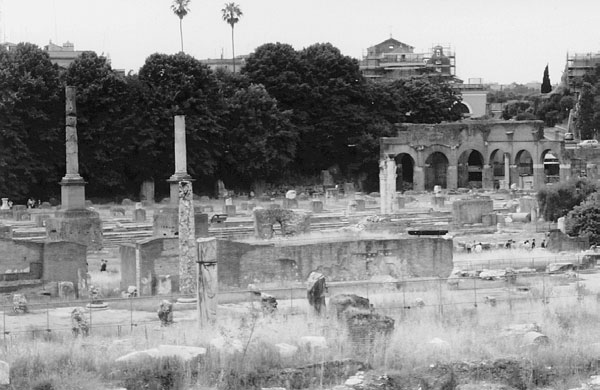Malaria and Rome: A History of Malaria in Ancient Italy (42 page)
Read Malaria and Rome: A History of Malaria in Ancient Italy Online
Authors: Robert Sallares
Tags: #ISBN-13: 9780199248506, #Oxford University Press, #USA, #History

²⁸ Ammerman (2000).
²⁹ Baccelli (1881: 156–7).
City of Rome
215
Table 8. Distribution of lakes within the city of Rome
Region
Name of region
Number
number
of lakes
1
Porta Capena
81
2
Caeleomontium
65
3
Isis et Serapis
65
4
Templum Pacis
71
5
Exquiliae
74
6
Altosemita
73
7
Via Lata
76
8
Forum Romanum Magnum
120
9
Circus Flaminius
120
10
Palatium
90
11
Circus Maximus
20
12
Piscina Publica
80
13
Aventinus
89
14
Transtiberim
180
Source
:
Curiosum urbis Romae regionum, xiiii. Libellus de regionibus urbis Romae,
ed. Nordh (1949). There are minor discrepancies in the figures between the
Curiosum
and the other list, the
Notitia
, and the repetition of certain figures may also raise some doubts about the accuracy of the data, but there is no doubt about the overall impression.
the
lacus Caprae
in the Campus Martius.³⁰ According to late antique catalogues of the features of the fourteen regions of the city of Rome, there were no less than 1,204 lakes within the city.
Hirsch in his monumental pioneering book on disease epidemiology was correct to state that ‘the Campagna di Roma . . . together with the city of Rome, forms one of the chief seats of the disease’, although it was on its way out of the city by then. By the end of the nineteenth century it was thought that infection no longer occurred within the walls of Rome itself, although numerous cases were still brought to hospitals in the city, such as the Santo Spirito, from the Roman Campagna, where it was still endemic. As recently as 1886, 66% of the communities of Latium were still classified as suffering from endemic malaria.³¹ Perhaps the most interesting account of a specific malaria epidemic in early modern Rome was given by Lancisi. In the second book of his famous work, published in 1717, ³⁰ Varro,
de lingua latina
5.43; Quilici (1979: 72–5).
³¹ Hirsch (1883: i. 214); Celli (1900: 86); the Inchiesta Jacini gave detailed information on the distribution of malaria in Latium.

216
City of Rome
32. Ospedale di Santo Spirito, the main hospital in Rome which received cases of malaria in the past. Also visible are the Lungotevere in Sassia river walls. The construction of effective river walls in the nineteenth century prevented malaria by stopping the River Tiber from flooding surrounding areas and so creating mosquito breeding sites.
he described at length the severe malaria epidemic which reached its height in August–September 1695. It affected principally the districts of the city closest to the Tiber, such as Trastevere and the Vatican. Lancisi mentioned all the main factors which have already been noted as prerequisites for malaria epidemics in the city of Rome (heavy rainfall which increased the volume of the Tiber, a Tiber flood, south winds, water overflowing from fountains, etc.). He noted that visitors to Rome were particularly badly affected, and described in detail the symptoms of the malarial fevers observed in that year.³² During the time of the Roman Empire the district of Trastevere, where the port facilities of ancient Rome along the Tiber have recently been discovered, according to newspaper reports, was intensively occupied. Procopius states that the Romans constructed so many houses in Trastevere that the ³² Lancisi (1717: esp. 193–7, 204–7, 244–6). Corradi (1865: ii. 278–84) reckoned that the epidemic of 1695 was a combination of malarial and petecchial fevers, and followed Haeser’s description of it as
febbre intermittente gastrico-tifico
(on which see Ch. 5. 2).

City of Rome
217
33. The Roman Forum was another lowlying district of the city of Rome, where there was a risk of malaria infection according to Horace.
River Tiber appeared to be in the middle of the city, instead of marking the boundary with hostile Etruscan territory as it had done in the earliest stages of Roman history.³³
In the light of the evidence of the medical geography of early modern Rome, it is not surprising that Rome was also troubled in antiquity. The Roman Forum was a dangerous place in antiquity, just as it was in 1870 according to Maggiorani. Horace described it as a place where one was likely to be infected with malaria in summer.³⁴ Similarly Juvenal testifies to the prevalence of malaria in Rome.³⁵ His evidence suggests that mixed infections with three different species of human malaria in the same person at the same time were common in ancient Rome, just as they were in those parts of Italy in more recent times where malaria was endemic. The importance of this piece of information is that it indicates a very ³³ Procopius,
BG
1.9.10: ojk≤aß sucn¤ß ƒn cwr≤8 t‘ åntipvraß deim3menoi mvson t[ß pÎlewß tÏ toı Tibvridoß pepo≤hntai Âeıma. Dionysius Hal.
AR
4.13.3–5 described the great extent of the suburbs of Rome.
³⁴ Horace,
Epist.
1.7.8–9:
officiosaque sedulitas et opella forensis adducit febris et testamenta resignat (and courteous officiousness and work in the Forum bring on fevers and open wills)
.
³⁵ Juvenal,
Sat.
4.56–7:
iam letifero cedente pruinis autumno, iam quartanam sperantibus aegris (Already deadly autumn is giving way to winter frosts, and sick people are now hoping for a quartan fever.), cf. Juvanal, 10.221.
218
City of Rome
high transmission rate of malaria. Ill people in ancient Rome
hoped for a quartan fever in late autumn because it signified a return to good health. Quartan fevers caused by
P. malariae
outlast more dangerous infections with
P. falciparum
and
P. vivax
, when all three are present at the same time in the same person, even though the quartan periodicity is masked by the more powerful rhythms of P. falciparum
and of
P. vivax
, which both invade a larger proportion of erythrocytes than
P. malariae
does.
Mathematical models of the interaction of
P. malariae
and
P. falciparum
in the human bloodstream suggest that
P. malariae
struggles to establish itself if
P. falciparum
is already present in an individual.
This explains the situation in tropical countries today.
P. malariae has often been judged to be quite rare in environments where
P.
falciparum
is active all the year round, using the traditional diagnostic technique of microscopic examination of blood smears on slides (although the modern techniques of molecular biology now suggest that it is in fact commoner even in tropical environments than used to be thought). However, the same mathematical models also yield the very important result that if a
P. malariae
infection occurs before an infection with
P. falciparum
, then
P. malariae
can establish itself, very significantly reduce the severity of a subsequent infection with P. falciparum
because of cross-species immunological reactions, and outlast
P. falciparum
.³⁶ The interaction of the two diseases is very significant. Livy tells us that many of the survivors of an epidemic (doubtless involving other diseases as well as malaria) in 174
ended up with quartan fever.³⁷ This constitutes evidence for the presence of endemic quartan fever in Latium by then. It is likely that frequent infections with
P. malariae
earlier in that particular year reduced the severity of a major epidemic of falciparum and vivax malaria in the late summer and autumn of that year. The survivorship rate might have actually
increased
in the short term, contrary to what would have been expected if
P. malariae
had not been present at all. However, it must be remembered that malarial infections as a whole did substantially reduce life expectancy in European historical populations in the long run (see Ch. 5. 4
above). Galen observed that quartan fever generally followed other ³⁶ Mason
et al
. (1999) wrote a very interesting article on the epidemiology of
P. malariae
and its interaction with
P. falciparum
.
³⁷ Livy 41.21.5:
qui superaverant, longinquo, maxime quartanae, implicabantur morbo
(the survivors were ill for a long time, particularly with quartan fever).
City of Rome
219
fevers instead of occurring on its own. This statement can only mean that multiple infections were normal.³⁸
for the most part quartan fever does not appear immediately at the beginning of the illness, but occurs after other fevers have manifested themselves³⁹
Cicero gives a specific example of this phenomenon, namely the case of Tiro:
since the essence of the disease has changed into a quartan fever (for so writes Curius), I hope that you [Tiro], with due diligence, will be even stronger⁴⁰
This letter is dated 12 January 49 , precisely the right time of year for that development. Scepticism is always possible with regard to the value of the evidence provided by an author like Juvenal, although in this particular case his words make perfectly good sense in the light of modern medical knowledge. Recent research in tropical countries employing the techniques of molecular biology to detect very low population densities of malaria parasites has shown that mixed infections (as well as subclinical chronic infections) are more frequent than was often thought previously when examination of blood smears under a microscope was the only means of detecting parasites. The ancient medical writers provide very important evidence confirming that
P. falciparum
malaria was indeed common among the population of the city of Rome from the second century to the second century . Caelius Aurelianus quoted Asclepiades of Bithynia, a Greek doctor who enjoyed great success at Rome (in spite of Cato’s condemnation of Greek medicine) in the late second century , according to ³⁸ Other ancient texts which mention this phenomenon include: Hippocrates,
Airs, Waters, Places
10: to»ß te perigenomvnouß ƒß tetarta≤ouß åpoteleut$n (the survivors ended up with quartan fevers); [Aristotle,]
Problems
1.19.861b tetarta∏oi g≤nontai to∏ß swzomvnoiß (those who were saved had quartan fevers); Galen 11.114K: πsti d’ oÍsin oÛk øl≤goisin ƒx £llwn puret0n ka≥ noshm3twn åpost3sieß ƒß tetarta≤ouß ƒg≤nonto (in many cases there was a transition from other fevers and diseases to quartan fevers). Galen is quoting Hippocrates Epidemics
, 1.6. Mixed infections were the norm in the town of Sermoneta in the Pontine region in the early twentieth century, according to Hackett (1937: 243). Similarly mixed infections were common in Greece (Balfour (1935: 312) ). Galen recognized mixed infections and wrote about them
e.g.
7.464–5K and 9.646K.
³⁹ Galen 11.18K: mhd’ eÛqŸß åp’ årc[ß t¤ poll¤ tÏn puretÏn toıton [sc. tetarta∏on]
ejsb3llein, åll’ ‰tvrwn proshghsamvnwn sump≤ptein.
⁴⁰ Cicero,
Epist. ad familiares
16.11.1:
cum in quartanam conversa vis est morbi (sic enim scribit Curius), spero te, diligentia adhibita, etiam firmiorem fore
.
220
City of Rome
Rawson’s redating of his floruit. Asclepiades may have invented the idea of seeds of disease that was employed by Lucretius.⁴¹
Asclepiades states that a persistent quotidian fever is not without danger . . . at Rome, he says, we notice that these fevers with a violent seizure of the body and mind, resembling lethargy, are frequent . . . he writes similar comments about these fevers, not once but frequently, saying that for a certain reason this seizing of the mind occurs in attacks of intermittent fevers, and that this is common at Rome.⁴²
Asclepiades states that quotidian fevers, the most dangerous manifestation of
P. falciparum
malaria, were common in Rome, frequently exhibited the symptoms of cerebral involvement called catalepsy or lethargy by ancient medical writers, and could be fatal.